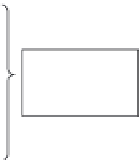Biomedical Engineering Reference
In-Depth Information
There are many theories and methodologies for how the brain issues motor con-
trol commands to the central nervous system to achieve a task. This chapter will
not address all reported methods but rather will focus on the method that is based
on optimization, which we believe is a natural process for completing a task.
3.3
Inducing behavior
One method for characterizing brain function to induce behavior in a digital
human is to give it the ability to process a task using the previously mentioned
cost functions. This theory was first introduced by the first author and his collea-
gues some time ago (Abdel-Malek et al., 2001a
d). A task is first broken into
sub-tasks, and then each sub-task is broken into procedures. This process is called
task planning and is well understood in the field of robotics. Subsequently, to
accomplish a procedure, the procedure planner selects one or more cost functions
from a list of available human performance measures to be used in an optimiza-
tion algorithm (
Figure 3.1
). Note that task planning and procedure planning are
forms of intelligent engines. Indeed, it is believed that selecting the appropriate
type of cost functions and understanding their relative importance is a challenging
problem that is not well understood. Nevertheless, optimizing for a combination
of cost functions yields a behavior that is different than that yielded by optimizing
TASK
Task
planning
Procedure
planning
Procedure 1...2...3...3...
n
Effort
Discomfort
Vision
Energy
Balance
Fatigue
Selection of
cost functions
Optimization
Task execution
FIGURE 3.1
The overall planning and execution of a task using the theory of optimization.









































Search WWH ::

Custom Search